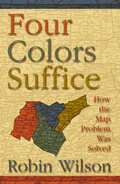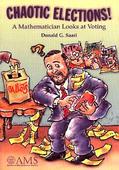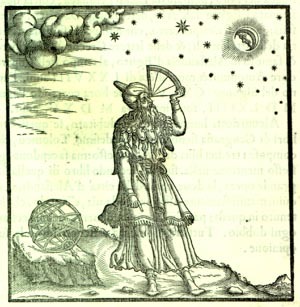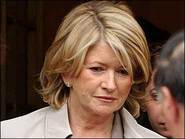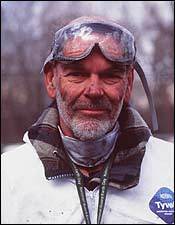
MINEOLA, LONG ISLAND - William "Rusty" Haight has survived more automobile crash tests than anyone else on Earth, and I'm dodging four lanes of traffic with him — on foot.
Rusty has flown out from San Diego to testify on a double-murder case. Two kids are drag-racing a Corvette and a Mercedes down a city street much like the one we just crossed, he explains, when they both plow into a turning Jeep, ripping it in half. The boys in the Corvette - "spoiled rich kids" driving Daddy's sports car, Rusty says - walk away, but the young couple in the Jeep are killed. They had just mailed out their wedding invitations and closed on a new home.
Rusty Haight is a car accident reconstructionist, maybe the best one there is. His job is to analyze all the physical evidence present at the scene of the crash - skidmarks, vehicle damage, injury patterns - and, using the laws of physics to run time in reverse, make an educated guess about how fast the drivers were going.
On this case his job is made easier by the black-box data recorder in the Corvette, which reads 139 miles per hour just seconds before the accident. All in all, the defendants don't have a chance, he says, which is why they switched lawyers at the last minute. He believes it's just a delaying tactic to postpone the trial and prevent him from testifying. But he'll be back when the trial reconvenes, he vows.
Haight, 45, with a sturdy build and an easy grin, is not your typical accident reconstructionist. For one thing, while most of his colleagues consult and testify for a living, Rusty's main business is "research and training," conducted through his San Diego-based Collision Safety Institute. By research, he means crashing cars together and seeing what happens, to better understand the damage he sees on the streets. By training, he means traveling the country to instruct and amaze the paying audiences of police officers and engineers who flock to his seminars on everything from motorcycle wrecks to "collision trauma biomechanics" (in short, injuries).
Getting into accidents might not seem like the most precise way to do forensic science. But Rusty's models of collision mechanics, from the simplest momentum analysis to the occasional full-fledged computer simulation, come with the ultimate guarantee: He'd stake his life on them. In fact, he has, 766 times and counting, at speeds up to 54 miles per hour.
In March, Men's Journal magazine ranked Rusty 24th on its list of the toughest men in America, right between 50 Cent and Hillary Clinton. "I look at it this way," he says soberly. "I came right behind the rapper who got shot nine times and survived, and right ahead of the gal who kicked the butt of the leader of the free world."
. . .
There are thousands of accident reconstructionists in the United States. Most of them work for police agencies, and rely on patrolmen to gather the reams of physical evidence they use as raw material for their calculations. Then there are the consultants, many of them aeronautical engineers laid off during the airline bust of the 1980s, who either work for forensics firms or sell their services directly to lawyers and insurance companies. Very few reconstructionists perform their own custom crashes in order to test a hypothesis or to prove a point. But all use the data gathered by the handful of experts who, like Rusty Haight, have chosen to become human crash-test dummies.
In studying high-speed accidents, where one can expect death or serious injury for all passengers, there is simply no substitute for crash-test dummies strapped into cars and thrust to their doom by a giant pulley or winch. The National Highway Traffic Safety Administration uses such high-speed dummy tests to set safety rules for car manufacturers.
But for low-speed collisions, which are more common but far less deadly, the government does not set manufacturing standards, or fund crash tests. To understand these accidents, there is often no substitute for human-driven cars with human bodies inside them. For one thing, dummies are stiffer than people, and are not designed to measure smaller impacts. Rusty has figured this out the hard way by letting a dummy ride shotgun with an identical set of sensors strapped to its head, chest, and limbs. While the readings from dummy sensors can be useful, they don't always match up with his own.
Since whole police departments generally can't travel to San Diego en masse, Rusty takes his crash-test show on the road. And since remote-control cars and dummy-friendly test tracks are hard to come by, he usually just finds a car locally, outfits it with a single accelerometer at its center of gravity (to measure how fast its speed is changing), and drives it into something himself.
He always wears kneepads, and sometimes wears Kevlar body armor to distribute the impact. But he never uses a helmet, which would prevent an accurate reading on his head-mounted accelerometer, one of several strapped to his body. Being behind the wheel, he explains, gives him the maneuverability he needs to investigate "nonstandard" crashes - weird combinations of vehicles, uncommon approach angles, and so on.
"What we do are the oddball tests," says Rusty, who has rammed cars into trucks, trucks into buses, school buses into cars, and more than one vehicle into a pole. "We do the 'Malibu-ramp-jump, hits-the-ground, hits-the-car' test. There's no federal standard for that." And, in addition to reading the car's built-in sensors after the fact, he adds speculatively, "we can explore what the speedometer tells us in the air" - another topic neglected by government research.
. . .
As long as there are low-speed car accidents, there will be a place for human-driven crash tests. But these days accident reconstructionists face a new job-security threat - not from crash-test dummies, but from onboard black boxes.
Used by airplanes and commercial vehicles for decades, the devices are quickly becoming standard in passenger cars. According to the National Transportation Safety Board - which this week recommended that data-recorders be installed in all passenger vehicles - about 15 percent of vehicles now on the road have them, with the figure estimated at between 65 percent and 90 percent for the 2004 fleet. Triggered by the airbag system, a black box will usually hold five seconds' worth of data on the car's speed and rotation before the crash, as well as its engine throttle and RPM and its seat belt and brake usage.
Black boxes have an uncertain legal status, with some judges requiring a search warrant for data to be admitted into evidence. (In Massachusetts they have been used in a handful of criminal cases, but no statewide standard for admitting or using black-box evidence has emerged. Citing privacy concerns, lawmakers in California, Maryland, and Virginia have tried to ban the devices altogether, but none have been successful so far.) Because they gather snapshots of fast-changing and unpredictable events, black boxes are not a perfect source of information that will take the guesswork out of the reconstructionist's job - or do away with it altogether.
Recently Rusty has testified in several cases that leaned heavily on black boxes, including the case against Bishop O'Brien of Phoenix, who was convicted of hit-and-run in February. But while black boxes provide a convenient way to verify his conclusions, he says they are not his primary source of data.
Rusty believes black boxes are useful not just for deciphering crashes but for stopping them from happening in the first place. Eventually, he says, when crash data filters back into the design process, it will help guide the next generation of crashworthy vehicles. Meanwhile, when insurance companies start cutting their rates for black-box equipped cars, all the automakers will jump on board. When everyone knows the devices are recording their actions, Rusty believes, reasonable drivers will drive more reasonably. But many reckless drivers will continue to be reckless.
. . .
By his own account, Rusty had a normal childhood in El Paso, Texas, with no more taste for cars - or carnage - than the next kid. An average science student, he spent a few years as a local reporter, then worked as a police officer in San Diego in the 1980s.
Working as a police investigator, he was drawn to accident reconstruction because it seemed like the only field where an individual could make a direct contribution to public safety. "Burglary and rape are sins of passion or opportunity," Rusty explains. "But crashes you can do something about. You can find a reason it occurred."
When asked about his heroes, Rusty cites Colonel John Paul Stapp, the doctor who served as "human decelerator" in dozens of 1950s Air Force deceleration experiments that produced better helmets and safety harnesses for aircraft pilots, and eventually led to a 1966 bill requiring seat belts in all new cars.
In one rocket-powered ride, the Colonel went from zero to 632 miles per hour in five seconds on a one-man sled mounted on a length of railroad track, then sustained over 40 Gs on braking, the equivalent of hitting a brick wall in a car going 120 miles per hour. According to legend, when Stapp, shaken and bleeding from more than one orifice, was informed by his assistant Captain Edward A. Murphy that the sensors had failed to record the run, Stapp replied drily, "Whatever can go wrong, will go wrong." The law has been attributed to Murphy ever since.
Rusty rolls up his sleeve to show me the only permanent damage he's received in two decades of live crash tests: a small scar on his upper wrist, from the seam of a life-saving airbag. "When I first started out, because there was an element of doubt, I would install my own seat belts. But now I . . . trust the stock seat belts," he says. His wife used to worry every time he got behind the wheel; now she straps herself into the passenger seat for the occasional crash.
For all his concern with public safety, Rusty (who drives a GMC Envoy when he's not planning on crashing, and admits to a few fender-benders) is not losing sleep over his own safety, judging by his three current short-term goals.
The first is to drive a car into water and live to tell the tale. "I have some friends who have done it," he says, but thanks in part to the absence of government research there is "no solid understanding" of aquatic crashes.
The second goal, he says, is to break "the 55-mile-per-hour glass ceiling," a purely psychological barrier. The way to do it and survive, he explains, is to drive a bigger car into a smaller one, in order to dilute your deceleration on impact. Haight thinks he can take the equivalent of hitting a brick wall at 27 miles per hour, which may sound like child's play compared to Stapp's records. "If I rammed a Hummer into a Hugo," he estimates casually, "I could probably do 70 miles per hour."
Rusty's third and most pressing objective - he calls it a "destructive personal goal" - is what the kids he came to Long Island to testify against did: split a car in half. He wants to do it without killing anyone, least of all himself. Luckily, he explains, with the right vehicle and approach angle, there's no need to go 139 miles per hour.
—Jascha Hoffman
THE CASE OF THE '62 SIMCA: SOLVING A 30-YEAR-OLD MURDER
OF ALL THE made-to-order crash tests Rusty Haight has performed in his years as an accident reconstructionist, the one that really sticks with him was the one that helped exonerate John Button, who was wrongly convicted of manslaughter for allegedly running over his teenage sweetheart in Western Australia almost three decades earlier.
On a February night in 1963, Button had a fight with his girlfriend at his parents' house in Perth. She stormed out and he followed her in his 1962 Simca, hoping she would come home with him. Shortly after he lost sight of her, she was hit by Eric Edgar Cooke, a serial killer who had terrorized the city for months with random murders, including several hit-and-run attempts. Moments later, as Cooke sped off in the Holden he'd stolen that night, Button discover his girlfriend bleeding and unconscious. Informed of her death at the hospital, then interrogated for hours in a state of shock, Button signed a confession saying that he ran her over. He served five years in prison, despite Cooke's later confessions to the murder.
In 1999, Button enlisted Haight to help him appeal the conviction once and for all. From archival photos of Button's car, Haight concluded that the "tiny ripple" in the hood "could have been caused by anything," and that the total lack of hair, skin, or clothing traces on the vehicle was "wholly inconsistent with a pedestrian impact."
Button was exonerated, but Haight didn't stop there. In February 2000, exactly 37 years after the night in question, he staged a public recreation of the accident, ramming three antique Simcas into a life-sized medical dummy. The impact consistently produced indentations much deeper than that found on Button's car in 1963. Meanwhile, a similar crash performed with a late-model Holden did not rule out the scenario that Cooke, who was hanged in 1964 for his murder spree, was the real culprit.
Button, 56, who watched dry-eyed during the Simca crashes, burst into tears after the Holden crash, overwhelmed to see the accident just as Cooke had described it in his confessions, according to Haight. Button was eventually awarded about $330,000 in US dollars as compensation for his wrongful imprisonment.
—Jascha Hoffman
